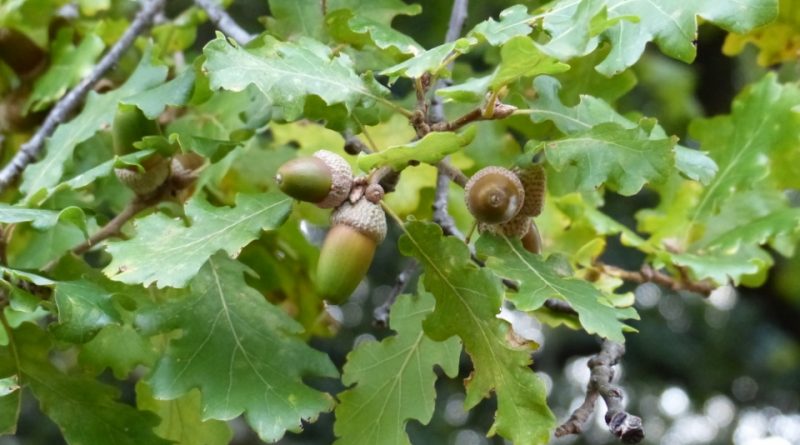Quercus pubescens
Quercus pubescens
The downy oak or pubescent oak (Quercus pubescens Willd., 1805) is an arboreal species belonging to the Fagaceae family.
Systematic –
From a systematic point of view it belongs to the Eukaryota Domain, Kingdom Plantae, Magnoliophyta Division, Magnoliopsida Class, Fagales Order, Fagaceae Family and therefore to the Quercus Genus and to the Q. pubescens Species.
The terms are synonyms: Quercus humilis Mill. And Quercus lanuginosa (Lam.) Thuill ..
Etymology –
The term Quercus derives directly from quercus, a name used by the Latins for the oak, a plant sacred to Jupiter. The specific epithet pubescens comes from pubes -is adolescent chin fluff: so covered with fluff, hairy, pubescent, downy.
Geographic Distribution and Habitat –
The pubescent oak is a plant native to southern Europe and Asia Minor with a vast distribution in the Mediterranean basin. In Italy it is the most common oak and is present everywhere, only with the exception of the inner and higher areas, especially in the sunniest places, on the slopes facing south at an altitude between sea level and 1000 m above sea level, where it forms pure or mixed woods, of tall trees or coppices. It grows on soils of different kinds, only fleeing from purely clayey soils, even if it often dominates on calcareous formations.
Description –
Quercus pubescens is a tree that does not exceed 20 meters in height and very polloniferous. The trunk is twisted, short, with sinuous branches and thin branches, with a gray-brownish bark, very wrinkled and cracked. The leaves are deciduous and simple, with an elongated ovoid lamina with rounded lobes. It is a monoecious plant that bears unisexual flowers; the fruit is an acorn with ovoid pericarp, shiny brown when ripe.
Cultivation –
The pubescent oak is a plant that tolerates all types of exposure, but if turned to the north, especially on moist soils, it easily becomes infected with fungal diseases. It prefers a calcareous soil, but it also adapts to clayey or stony soils, not to acid ones. At the time of planting it is necessary to take special care of the drainage, given that it fears water stagnation. At the plant it is necessary to administer a well-mature manure shovel or dry manure. For his government, as it is a plant that tends to form many suckers, these must be eliminated every year if you want to get a plant with an arboreal habit, also because it is a slow-growing tree.
Uses and Traditions –
Quercus pubescens is the most widespread oak species in Italy, so much so that in many places it is simply called oak. It is widespread from the Po Valley down, especially in the hills and along the Apennine ridge. In the Umbrian-Marche Apennines and in Tuscany the mixed oak woods of pubescent oak are the source of the precious white truffle (Tuber magnatum). It is a very long-lived species that can reach 1000 years of age. In Italy there are downy oaks that are over 500 years old, of which one in Tricarico (MT), in the locality Grottone which is estimated to be 612 years old, another estimated around 750 years in the Municipality of Scurcola Marsicana (AQ) and finally another one in Lucera (FG), which has an estimated age of 900 years. But the largest seems to be in Sardinia to Illorai (SS) with a multi-millennial age inserted in a forest of natural evolution managed by the Forests of Sardinia.
The pubescent oaks, especially in central-southern Italy and in the past left along the boundaries of property, so that it was possible in some cases to reconstruct these boundaries by examining the presence of large specimens of the species.
It is a plant appreciated and used as firewood, is part of the category of hard woods, or those woods that have excellent calorific value and slow combustion. The wood of Roverella is similar to that of Farnia, although more irregular and more difficult to work. However, it presents less straight fibers, which is more difficult to process, and tends to embark. The beams that are obtained are used in construction, shipbuilding and once railway sleepers. The acorns of the Roverella are sweet and, once, were used not only for the feeding of pigs but also, in times of famine, to make a kind of bread or acorn piadina.
Preparation Mode –
Quercus pubescens is a species that today has uses as timber and in the forest field; once its sweet acorns were used not only for the feeding of pigs but also, in times of famine, to produce a flour from which it was obtained a kind of bread or acorn piadina.
Guido Bissanti
Sources
– Acta Plantarum – Flora of the Italian Regions.
– Wikipedia, the free encyclopedia.
– Treben M., 2000. Health from the Pharmacy of the Lord, Advice and experience with medicinal herbs, Ennsthaler Publisher
– Pignatti S., 1982. Flora d’Italia, Edagricole, Bologna.
– Conti F., Abbate G., Alessandrini A., Blasi C. (edited by), 2005. An annotated checklist of the Italian vascular flora, Palombi Editore.
Warning: Pharmaceutical applications and alimurgical uses are indicated for informational purposes only and do not in any way represent a medical prescription; there is therefore no liability for their use for curative, aesthetic or food purposes.


